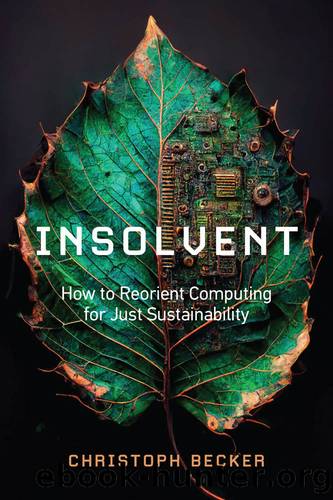Insolvent by Christoph Becker

Author:Christoph Becker
Language: eng
Format: epub
Tags: Sustainability; sustainable HCI; intertemporal choice; just sustainabilities; ICT for Sustainability; critical computing; design decisions; systems thinking; sustainable development;
Publisher: MIT Press
THE EMERGENCE OF NATURALISTIC DECISION-MAKING
When it became undeniable that the assumptions, predictions, and methods of rationalist decision theory as exposed in mainstream psychology and behavioral economics were questionable, some researchers concluded that they should be set aside. This involved three shifts. First, they abandoned the âclassicalâ rationalist theory: âclassical theory cannot continue to be used as the standard for evaluating all decision behavior.⦠It is time to stop patching and propping an inappropriate theory. It is time to create a more useful theoryâ (Beach and Lipshitz 1993, 35). They started anew to develop new theories by focusing on behavior not norms (Beach and Lipshitz 1993; Zsambok and Klein 1997).
Second, they abandoned the method of lab experiments: âmany compromises have to be made to perform controlled experiments. The restriction on context, the absence of meaningful consequences, the use of tasks with well-defined goals, and particularly the elimination of expertise in studies presenting unfamiliar tasks, all raise doubts about whether the findings of these studies can be generalized to natural settingsâ (Klein and Wright 2016). Instead, they went into the field and studied professionals who were making important decisions, such as firefighters, military commanders, surgeons, and engineering designers. They followed their day-to-day activities to observe and ask about the decisions they were making. This is why their research became known as naturalistic decision-making research (NDM).
Third, in contrast to the view on biases and shortcomings of human decisions, they were interested in how highly experienced individuals made decisions very well. Through this work, NDM researchers developed a toolbox of research methods and guidance called Cognitive Task Analysis (Crandall, Klein, and Hoffman 2006; G. Klein 2000; Schraagen, Chipman, and Shalin 2000). A central component is that they expanded the horizon of the system of interest from the individual mind to the situation and its factors. This view of macrocognition (Klein et al. 2003; Klein and Wright 2016) incorporates an appreciation of the relevant factors that combine in each situation differently to shape the outcomes of decision-making. It places the individuals and groups engaging in decision-making into a concrete situation and emphasizes the content and texture of that situation. This formed an entirely new paradigm distinct from rationalist research, with different base metaphors, methods, and evaluation of validity.
Whereas the behavioral decision-making community focuses on human limitations and seeks ways to reduce biases and mistakes, the NDM community, as it performs macrocognitive research, focuses on human capabilities and regards good performance as much more than the absence of mistakes. Good performance is also about discoveries and insights; it is about the strengths of decision makers, and the importance of experience. Experience serves a variety of functions including a larger repertoire of patterns and associated actions, a richer mental model of how things work to support inferential reasoning and sensemaking for diagnosis and anticipation. (Klein and Wright 2016, 3)
What they found was remarkable (G. Klein 1998; Zsambok and Klein 1997). Initially, they found no âdecisionsâ at all: people denied making choices among options. This made little sense at first.
Download
This site does not store any files on its server. We only index and link to content provided by other sites. Please contact the content providers to delete copyright contents if any and email us, we'll remove relevant links or contents immediately.
| AI & Machine Learning | Bioinformatics |
| Computer Simulation | Cybernetics |
| Human-Computer Interaction | Information Theory |
| Robotics | Systems Analysis & Design |
Algorithms of the Intelligent Web by Haralambos Marmanis;Dmitry Babenko(9831)
Test-Driven Development with Java by Alan Mellor(7635)
Data Augmentation with Python by Duc Haba(7521)
Principles of Data Fabric by Sonia Mezzetta(7291)
Learn Blender Simulations the Right Way by Stephen Pearson(7215)
Microservices with Spring Boot 3 and Spring Cloud by Magnus Larsson(7044)
Jquery UI in Action : Master the concepts Of Jquery UI: A Step By Step Approach by ANMOL GOYAL(6445)
RPA Solution Architect's Handbook by Sachin Sahgal(6443)
The Infinite Retina by Robert Scoble Irena Cronin(6145)
Hadoop in Practice by Alex Holmes(6135)
Big Data Analysis with Python by Ivan Marin(5875)
Life 3.0: Being Human in the Age of Artificial Intelligence by Tegmark Max(5472)
Pretrain Vision and Large Language Models in Python by Emily Webber(4826)
Infrastructure as Code for Beginners by Russ McKendrick(4611)
WordPress Plugin Development Cookbook by Yannick Lefebvre(4329)
Functional Programming in JavaScript by Mantyla Dan(4215)
The Age of Surveillance Capitalism by Shoshana Zuboff(4205)
Embracing Microservices Design by Ovais Mehboob Ahmed Khan Nabil Siddiqui and Timothy Oleson(4102)
Applied Machine Learning for Healthcare and Life Sciences Using AWS by Ujjwal Ratan(4078)
